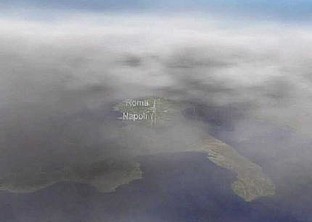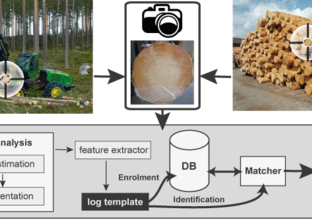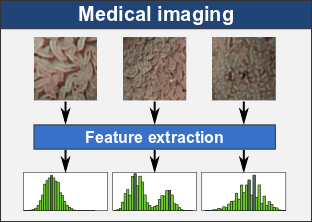Following are some example projects of the AISP master program.
Watermarking of Polygonal Data
 We study the watermarking of 2D vector data and introduce a framework which preserves topological properties of the input. Our framework is based on so-called maximum perturbation regions (MPR) of the input vertices, which is a concept similar to the just-noticeable-difference constraint. The MPRs are computed by means of the Voronoi diagram or constrained Delaunay triangulations of the input and allow us to avoid (self-)intersections of input objects that might result from the embedding of the watermark. We demonstrate and analyze the applicability of this new framework by coupling it with a well-known approach to watermarking that is based on Fourier descriptors. However, our framework is general enough such that any robust scheme for the watermarking of vector data can be applied.
We study the watermarking of 2D vector data and introduce a framework which preserves topological properties of the input. Our framework is based on so-called maximum perturbation regions (MPR) of the input vertices, which is a concept similar to the just-noticeable-difference constraint. The MPRs are computed by means of the Voronoi diagram or constrained Delaunay triangulations of the input and allow us to avoid (self-)intersections of input objects that might result from the embedding of the watermark. We demonstrate and analyze the applicability of this new framework by coupling it with a well-known approach to watermarking that is based on Fourier descriptors. However, our framework is general enough such that any robust scheme for the watermarking of vector data can be applied.
Selected research projects:
www.cosy.sbg.ac.at/~held/work.html
Selected publications:
-
S. Huber, M. Held, R. Kwitt, P. Meerwald (2014):
"Topology-Preserving Watermarking of Vector Data".
Int. J. Computational Geometry and Applications, 24(1):61--86, Mar 2014.
-
S. Huber, M. Held, R. Kwitt, P. Meerwald (2012):
"Topology-Preserving Watermarking of Vector Data".
Proc. 28th Europ. Workshop Computational Geometry, p. 77-80, Assisi, Perugia, Italy, Mar 2012.
-
S. Huber, R. Kwitt, P. Meerwald, M. Held, A. Uhl (2010):
"Watermarking of 2D Vector Graphics with Distortion Constraint".
IEEE Int. Conf. on Multimedia & Expo (ICME 2010), p. 480--485, Singapore, July 2010.
Realistic Visualization of Clouds Based on Metereological Data
 In this project we study the modeling, visualization and animation of realistic clouds on the basis of numerical weather prediction models. Our approach to visualizing clouds is based on a particle system that consists of soft balls, so-called metaballs. Particular attention is given to the special requirements of large-scale cloud visualizations. Since weather forecast data typically lacks specific information on the small-scale structure of clouds we have to interprete weather data in order to extract information on the appearance of the clouds, thereby obtaining five visual cloud classes. Based on this cloud extraction and classification, modeling techniques for each visual cloud class were developed. For the actual rendering we extend and adapt the metaball approach by introducing flattened particles and derived metaball textures. Our approach yields a large-scale, realistic, 3D cloud visualization that supports cloud fly-throughs.
In this project we study the modeling, visualization and animation of realistic clouds on the basis of numerical weather prediction models. Our approach to visualizing clouds is based on a particle system that consists of soft balls, so-called metaballs. Particular attention is given to the special requirements of large-scale cloud visualizations. Since weather forecast data typically lacks specific information on the small-scale structure of clouds we have to interprete weather data in order to extract information on the appearance of the clouds, thereby obtaining five visual cloud classes. Based on this cloud extraction and classification, modeling techniques for each visual cloud class were developed. For the actual rendering we extend and adapt the metaball approach by introducing flattened particles and derived metaball textures. Our approach yields a large-scale, realistic, 3D cloud visualization that supports cloud fly-throughs.
http://www.cosy.sbg.ac.at/~held/projects/clouds/clouds.html
Selected research projects:
www.cosy.sbg.ac.at/~held/work.html
Selected publications:
-
R. Hufnagel, M. Held (2014):
"Animation of Clouds Based on the Interpolation of Weather Forecast Data".
2nd EuroVis Workshop on the Visualization in Environmental Sciences (EnvirVis '14), p. 25-29; June 2014; Swansea, Wales, UK.
-
R. Hufnagel, M. Held (2012):
"A Survey of Cloud Lighting and Rendering Techniques".
Proc. 20th Internat. Conf. Comput. Graphics, Visualizat., Comput. Vision (WSCG'12), J. WSCG 20(3), p. 53-63; June 25-28, 2012; Plzen, Czech Republic.
-
R. Hufnagel, M. Held, Florian Schröder (2007):
"Large-Scale, Realistic Cloud Visualization Based On Weather Forecast Data".
Proc. 9th IASTED Int. Conf. Comput. Graph. Imaging (CGIM'07), p. 54--59; February 13-15, 2007; Innsbruck, Austria.
Biometric wood log tracking using end face images
 In this project the feasibility and basic issues of biometric log identification using log end images are investigated. Similar as for human biometrics and fingerprints or iris images as biometric characteristics it is assumed that annual ring patterns of different tree logs are discriminative. Digital representations of annual ring pattern features are entitled as biometric templates. For this purpose, the applicability of fingerprint and iris approaches to annual ring patterns is assessed and new feature extraction approaches are developed. In the context of biometric template computation our research contributes to the development of typical log end image analysis tasks like pith estimation and segmentation. Most important of all, our research draws conclusions about the biometric performance for a large set of tree logs and the robustness of biometric log identification to issues which arise in an industrial application.
In this project the feasibility and basic issues of biometric log identification using log end images are investigated. Similar as for human biometrics and fingerprints or iris images as biometric characteristics it is assumed that annual ring patterns of different tree logs are discriminative. Digital representations of annual ring pattern features are entitled as biometric templates. For this purpose, the applicability of fingerprint and iris approaches to annual ring patterns is assessed and new feature extraction approaches are developed. In the context of biometric template computation our research contributes to the development of typical log end image analysis tasks like pith estimation and segmentation. Most important of all, our research draws conclusions about the biometric performance for a large set of tree logs and the robustness of biometric log identification to issues which arise in an industrial application.
Selected research projects:
Traceability of logs by means of digital images (TreeBio) [ www.wavelab.at/project-treebio.shtml]
Selected publications:
-
[Schraml13a] Rudolf Schraml, Andreas Uhl, "Pith Estimation on Rough Log End Images using Local Fourier Spectrum Analysis", In Proceedings of the 14th Conference on Computer Graphics and Imaging (CGIM'13), Innsbruck, AUT, Feb. 2013
-
[Schraml14a] Rudolf Schraml, Johann Charwat-Pessler, Andreas Uhl, "Temporal and longitudinal variances in wood log cross-section image analysis", In IEEE International Conference on Image Processing (ICIP 2014), Paris, FR, Oct. 2014, accepted
-
[Schraml14b] Rudolf Schraml, Andreas Uhl, "Similarity based cross-section segmentation in rough log end images", In L. Iliadis and others, editors, Proceedings of the 10th Artificial Intelligence Applications and Innovations Conference (AIAI 2014), pp. 614-621, Rhodes, GR, IFIP AICT, 436, sept 2014
RoI encryption
 In region of interest (RoI) encryption, not the whole image or video is encrypted, but only a part thereof. In surveillance scenarios, for example, faces as regions of interest are often encrypted, while the other regions remain unchanged. At the University of Salzburg, RoI encryption approaches for a variety of image and video formats have been developed, including JPEG, JPEG2000, JPEG XR, H.264 and SVC.
In region of interest (RoI) encryption, not the whole image or video is encrypted, but only a part thereof. In surveillance scenarios, for example, faces as regions of interest are often encrypted, while the other regions remain unchanged. At the University of Salzburg, RoI encryption approaches for a variety of image and video formats have been developed, including JPEG, JPEG2000, JPEG XR, H.264 and SVC.
Selected research projects:
Privacy-protected Video Surveillance on Scalable Bitstreams [ www.wavelab.at/project-privsurv.shtml]
Selected publications:
-
Dominik Engel, Andreas Uhl, Andreas Unterweger, "Region of Interest Signalling for Encrypted JPEG Images", In IH&MMSec'13: Proceedings of the 1st ACM Workshop on Information Hiding and Multimedia Security, pp. 165-174, ACM, June 2013
-
Andreas Unterweger, Andreas Uhl, "Slice Groups for Post-Compression Region of Interest Encryption in SVC", In IH&MMSec'14: Proceedings of the 2014 ACM Information Hiding and Multimedia Security Workshop, pp. 15-22, Salzburg, Austria, ACM, June 2014
-
J. Hämmerle-Uhl, S. Jenisch, A. Uhl, "Format Compliant RoI Encryption of JPEG XR Bitstreams Based on Tiling", In Proceedings of the 21st European Signal Processing Conference, EUSIPCO '13, Marrakech, Morocco, Sep. 2013
Computer-Aided Diagnosis in Endoscopy
 Today, medical endoscopy is a widely used procedure to inspect the inner cavities of the human body. The advent of endoscopic imaging techniques - allowing the acquisition of images or videos - created the possibility for the development of the whole new branch of computer-aided decision diagnosis systems. Such systems aim at helping physicians to identify possibly malignant abnormalities more accurately. At the University of Salzburg, we develop different algorithms to establish such a system.
Today, medical endoscopy is a widely used procedure to inspect the inner cavities of the human body. The advent of endoscopic imaging techniques - allowing the acquisition of images or videos - created the possibility for the development of the whole new branch of computer-aided decision diagnosis systems. Such systems aim at helping physicians to identify possibly malignant abnormalities more accurately. At the University of Salzburg, we develop different algorithms to establish such a system.
Selected research projects:
www.wavelab.at/project-undistort.shtml
www.wavelab.at/project-colonHD.shtml
Selected publications:
[Liedlgruber11e ] Michael Liedlgruber, Andreas Uhl, "Computer-aided Decision Support Systems for Endoscopy in the Gastrointestinal Tract: A Review", IEEE Reviews in Biomedical Engineering 4, pp. 73-88, 2012
[Hegenbart13a] Sebastian Hegenbart, Andreas Uhl, Andreas Vécsei, Georg Wimmer, "Scale invariant texture descriptors for classifying celiac disease", Medical Image Analysis 17:4, pp. 458-474, 2013
[Haefner12a] M. Häfner, M. Liedlgruber, A. Uhl, A. Vécsei, F. Wrba, "Delaunay Triangulation-based Pit Density Estimation for the Classification of Polyps in High-magnification Chromo-colonoscopy", Computer Methods and Programs in Biomedicine 107:3, pp. 565-581, 2012
Transparent encryption
 Encryption does not always equal the complete distortion of an image or video. In contrast, in the case of transparent encryption, the image quality is only reduced so far as to make the viewing experience unpleasent for the viewer. A typical use case for this is Pay TV where a transparently encrypted low quality signal is available for free and aims at motivating the viewer to purchase the higher quality (decrypted) option. At the University of Salzburg, transparent encryption approaches for a variety of image and video formats have been developed, including JPEG, JPEG2000 and H.265.
Encryption does not always equal the complete distortion of an image or video. In contrast, in the case of transparent encryption, the image quality is only reduced so far as to make the viewing experience unpleasent for the viewer. A typical use case for this is Pay TV where a transparently encrypted low quality signal is available for free and aims at motivating the viewer to purchase the higher quality (decrypted) option. At the University of Salzburg, transparent encryption approaches for a variety of image and video formats have been developed, including JPEG, JPEG2000 and H.265.
Selected publications:
-
Heinz Hofbauer, Andreas Uhl, Andreas Unterweger, "Transparent Encryption for HEVC Using Bit-Stream-Based Selective Coefficient Sign Encryption", In 2014 IEEE International Conference on Acoustics, Speech and Signal Processing (ICASSP), pp. 1986-1990, Florence, Italy, IEEE, May 2014
-
Thomas Stütz, Vinod Pankajakshan, Florent Autrusseau, Andreas Uhl, Heinz Hofbauer, "Subjective and Objective Quality Assessment of Transparently Encrypted JPEG2000 Images", In Proceedings of the ACM Multimedia and Security Workshop (MMSEC '10), pp. 247-252, Rome, Italy, ACM, September 9 - 10, 2010
Watermarking
 Watermarking, both visible and invisible, allows embedding information into an image or video so that it can be retrieved later. This is typically used for digital rights management (DRM) applications like video-on-demand (VoD) streaming. At the University of Salzburg, watermarking approaches for a variety of image and video formats have been developed, including JPEG2000, H.264 and SVC.
Watermarking, both visible and invisible, allows embedding information into an image or video so that it can be retrieved later. This is typically used for digital rights management (DRM) applications like video-on-demand (VoD) streaming. At the University of Salzburg, watermarking approaches for a variety of image and video formats have been developed, including JPEG2000, H.264 and SVC.
Selected research projects:
Structure-Preserving State-of-The-Art Video Watermarking [ www.wavelab.at/project-structWM.shtml]
Selected publications:
-
Thomas Stütz, Florent Autrusseau, Andreas Uhl, "Non-blind structure-preserving substitution watermarking of H.264/CAVLC inter-frames", IEEE Transactions on Multimedia 16:5, pp. 1337-1349, 2014
-
Jan De Cock, Heinz Hofbauer, Thomas Stütz, Andreas Uhl, Andreas Unterweger, "An Industry-Level Blu-ray Watermarking Framework", Multimedia Tools and Applications, Springer, 2014, to appear.
Hippocampus Analysis in MRI
 The aim of the project is to identify pysiological markers which allow to distinguish between generic memory decline (i.e. mild cognitive impairment MCI) and MCI associated with temporal lobe epilepsy. The pysiological data considered are MRT scans and EEG data. The particular contribution of the University of Salzburg is MRT segmentation with emphasis on the hippocampus and derivation of sensible features as well as the application of ensemble classification techniques.
The aim of the project is to identify pysiological markers which allow to distinguish between generic memory decline (i.e. mild cognitive impairment MCI) and MCI associated with temporal lobe epilepsy. The pysiological data considered are MRT scans and EEG data. The particular contribution of the University of Salzburg is MRT segmentation with emphasis on the hippocampus and derivation of sensible features as well as the application of ensemble classification techniques.
Selected research projects:
www.wavelab.at/project-memdecline.shtml

